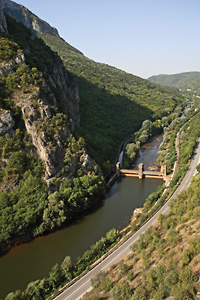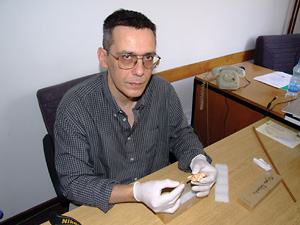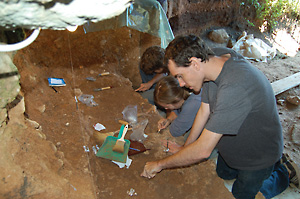Discoveries
BELGRADE ARCHEOLOGISTS CHANGE THE PALEOLITHIC REPRESENTATION OF SERBIA AND EUROPE
Prehistoric Man from Sićevo
The news released by Reuters in 2006 went unnoticed in Serbia. The remains of a hominid at least 150.000, probably several times more years old, were discovered in the Velika and Mala Balanica caves, in the famous gorge between Niš and Pirot! This year, the Belgrade research team will be accompanied by the Winnipeg University (Canada), University of Bordeaux (France), Hamilton University (USA) and Oxford (Great Britain). Perhaps it wouldn’t be bad if we were more seriously interested in our case, would it?
NR Press
Photo: Balanica research project
documentation and Dragan Bosnić
 Until only a few decades ago, almost nothing was known about the Paleolithic history of Serbia (older Stone Age). Jovan Cvijić and Djoka Jovanović, the great men of the then science, had already searched for the traces of the ”caveman”, as the scientists called it 150 years ago. The situation until about 30 years ago was almost the same as in the mid-XIX century – a relatively small number of objects related to the Paleolithic were found, and only a few ”potential teeth” from the skeletal remains of our ancient ancestors. In time, a theory was accepted that there are simply no skeletal remains, and the area of Serbia was almost empty on the map of ”Paleolithic Europe”. Until only a few decades ago, almost nothing was known about the Paleolithic history of Serbia (older Stone Age). Jovan Cvijić and Djoka Jovanović, the great men of the then science, had already searched for the traces of the ”caveman”, as the scientists called it 150 years ago. The situation until about 30 years ago was almost the same as in the mid-XIX century – a relatively small number of objects related to the Paleolithic were found, and only a few ”potential teeth” from the skeletal remains of our ancient ancestors. In time, a theory was accepted that there are simply no skeletal remains, and the area of Serbia was almost empty on the map of ”Paleolithic Europe”.
In the late summer of 2006, the Reuters agency released the news that archeologists discovered fossil remains of a Paleolithic man in a cave near Niš, however the information went almost unnoticed in Serbia. Only during the previous few years, something appeared in local newspapers and TV, but it seems that the public is still not informed about the importance of the archeological discovery of the ”prehistoric man from Sićevo”. The discovery was made in two caves in the village of Sićevo – Velika and Mala Balanica – only 10 meters away from each other.
– Archeological explorations began already in 2004 – says Professor Dušan Mihailović, PhD, from the Belgrade Faculty of Philosophy, the best expert in the Paleolithic in Serbia for National Review, the man who enriched us with this great discovery. – However, we had to wait two years, until 2006, for the discovery of this ”prehistoric man”. Until then,  several thousand stone tools produced by the Neanderthal had been discovered in both caves, but we had no indications of traces of older members of the human species in the cave. The finding was almost accidental, as is usually the case with big archeological discoveries. During the break between two archeological campaigns, local ”treasure hunters” (and there are already more than enough of them in this part of Serbia – editor’s remark) dug a narrow, 4 meters deep hole in the interior of Mala Balanica, which is extremely dangerous for caves. After the locals have informed us that the ”gold-diggers” dug through the cave, I went to the site with some people from my team and collected all objects from the dug out soil. Among other findings, we discovered a lower jaw of a hominid, which today represents the oldest known inhabitant of Serbia. We first thought that the jaw belongs to a Neanderthal, whose tools we had already found in Balanica, but it turned out that the bone is much older and belongs to the species that lived much before them in this area. several thousand stone tools produced by the Neanderthal had been discovered in both caves, but we had no indications of traces of older members of the human species in the cave. The finding was almost accidental, as is usually the case with big archeological discoveries. During the break between two archeological campaigns, local ”treasure hunters” (and there are already more than enough of them in this part of Serbia – editor’s remark) dug a narrow, 4 meters deep hole in the interior of Mala Balanica, which is extremely dangerous for caves. After the locals have informed us that the ”gold-diggers” dug through the cave, I went to the site with some people from my team and collected all objects from the dug out soil. Among other findings, we discovered a lower jaw of a hominid, which today represents the oldest known inhabitant of Serbia. We first thought that the jaw belongs to a Neanderthal, whose tools we had already found in Balanica, but it turned out that the bone is much older and belongs to the species that lived much before them in this area.
ASSUMPTIONS AND FURTHER WORK
 Besides the part of a jaw, several other bones belonging to the same hominid were found. All remains were deep under the layer in which Neanderthal objects were found. Mirjana Roksandić, originally from Serbia, now anthropology professor at the Winnipeg University in Canada, analyzed the excavated skeletal remains and confirmed it is a specimen with many archaic characteristics. The age analysis done in the most prestigious world laboratories verified that the bones can certainly be dated to 150.000 years ago, although they could also be several times older. No objects which could be related to this prehistoric man were found in its vicinity, but a stone tool, probably of the same age as the hominid fossil, was found in the Velika Balanica cave. Professor Mihailović explains us how the remains of the ”prehistoric man from Sićeva” could have reached the cave. Besides the part of a jaw, several other bones belonging to the same hominid were found. All remains were deep under the layer in which Neanderthal objects were found. Mirjana Roksandić, originally from Serbia, now anthropology professor at the Winnipeg University in Canada, analyzed the excavated skeletal remains and confirmed it is a specimen with many archaic characteristics. The age analysis done in the most prestigious world laboratories verified that the bones can certainly be dated to 150.000 years ago, although they could also be several times older. No objects which could be related to this prehistoric man were found in its vicinity, but a stone tool, probably of the same age as the hominid fossil, was found in the Velika Balanica cave. Professor Mihailović explains us how the remains of the ”prehistoric man from Sićeva” could have reached the cave.
– It was probably not a funeral, since archeology and anthropology have no confirmation about burials of hominids before the appearance of Neanderthals. Perhaps this hominid died in an accident nearby, or perhaps in the cave, since his remains were discovered together with the remains of hyena, cave bear and ibex. It is also possible that the remains came to this place by natural sedimentation, or that they were brought to the cave by a vulture of that time – cave hyena.
 This discovery, adds Professor Mihailović, is important for understanding the development of the human species in the whole of Europe. This discovery, adds Professor Mihailović, is important for understanding the development of the human species in the whole of Europe.
– There are only a few such findings, due to the probably small population of the representatives of the species in this period, or due to inadequate climate and characteristics of our soil. In warmer regions, layers of earth are not as aggressive as it is the case here, so perhaps that is why those regions have more of our ancestors’ fossil remains. For that reason too, the significance of this finding is enormous for the study of the human past.
The site is located on a branch of Corridor 10, at the very entrance of the Sićevo Gorge, a natural park. There is a big hotel nearby. Other cave dwellings in the vicinity are also explored, so Balanica and its surrounding can easily become an important tourist destination. It is also important that the Serbian Ministry of Culture recognized this site as one of the most important archeological sites and finances a part of the research campaign each year.
***
Together
This year the Belgrade research team has been accompanied by the Winnipeg University from Canada, whose students and experts will be able to gain great experience at this unique site. Besides them, internationally recognized scientists from the University of Bordeaux (France), Hamilton University (USA) and University of Oxford (Great Britain) also joined the project of exploring Velika and Mala Balanica.
***
To Do List
The access to the cave is not in a good state and there are no paths or signs, which is within the jurisdiction of local authorities. The caves are now protected from gold-diggers with strong bars. Professor Dušan Mihailović, PhD notes that the Croatian prime minister recently opened a museum, into which more than a million Euros had been invested, near the famous site with the remains of the Neanderthal man in the famous Krapina, Croatia. We hope a similar ”temple of culture” will also be opened in Sićevo and therefore enable this region to offer more in general and tourism-wise.
|
